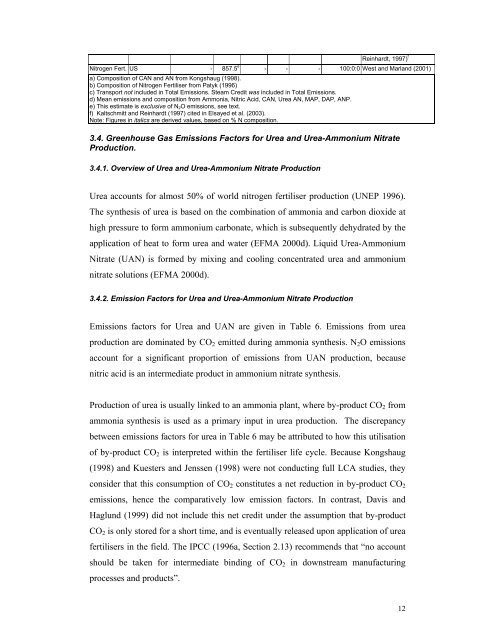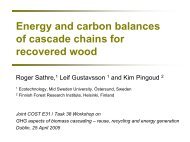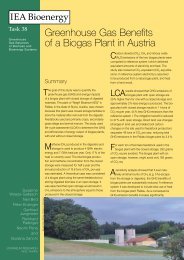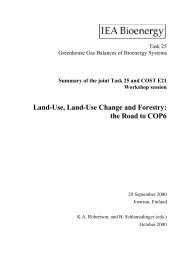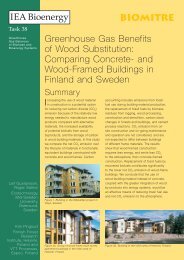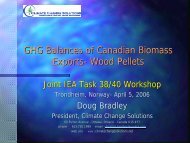A review of greenhouse gas emission factors for fertiliser production.
A review of greenhouse gas emission factors for fertiliser production.
A review of greenhouse gas emission factors for fertiliser production.
You also want an ePaper? Increase the reach of your titles
YUMPU automatically turns print PDFs into web optimized ePapers that Google loves.
Reinhardt, 1997) fNitrogen Fert. US - 857.5 e - - - 100:0:0 West and Marland (2001)a) Composition <strong>of</strong> CAN and AN from Kongshaug (1998).b) Composition <strong>of</strong> Nitrogen Fertiliser from Patyk (1996)c) Transport not included in Total Emissions. Steam Credit was included in Total Emissions.d) Mean <strong>emission</strong>s and composition from Ammonia, Nitric Acid, CAN, Urea AN, MAP, DAP, ANP.e) This estimate is exclusive <strong>of</strong> N 2O <strong>emission</strong>s, see text.f) Kaltschmitt and Reinhardt (1997) cited in Elsayed et al. (2003).Note: Figures in italics are derived values, based on % N composition.3.4. Greenhouse Gas Emissions Factors <strong>for</strong> Urea and Urea-Ammonium NitrateProduction.3.4.1. Overview <strong>of</strong> Urea and Urea-Ammonium Nitrate ProductionUrea accounts <strong>for</strong> almost 50% <strong>of</strong> world nitrogen <strong>fertiliser</strong> <strong>production</strong> (UNEP 1996).The synthesis <strong>of</strong> urea is based on the combination <strong>of</strong> ammonia and carbon dioxide athigh pressure to <strong>for</strong>m ammonium carbonate, which is subsequently dehydrated by theapplication <strong>of</strong> heat to <strong>for</strong>m urea and water (EFMA 2000d). Liquid Urea-AmmoniumNitrate (UAN) is <strong>for</strong>med by mixing and cooling concentrated urea and ammoniumnitrate solutions (EFMA 2000d).3.4.2. Emission Factors <strong>for</strong> Urea and Urea-Ammonium Nitrate ProductionEmissions <strong>factors</strong> <strong>for</strong> Urea and UAN are given in Table 6. Emissions from urea<strong>production</strong> are dominated by CO 2 emitted during ammonia synthesis. N 2 O <strong>emission</strong>saccount <strong>for</strong> a significant proportion <strong>of</strong> <strong>emission</strong>s from UAN <strong>production</strong>, becausenitric acid is an intermediate product in ammonium nitrate synthesis.Production <strong>of</strong> urea is usually linked to an ammonia plant, where by-product CO 2 fromammonia synthesis is used as a primary input in urea <strong>production</strong>. The discrepancybetween <strong>emission</strong>s <strong>factors</strong> <strong>for</strong> urea in Table 6 may be attributed to how this utilisation<strong>of</strong> by-product CO 2 is interpreted within the <strong>fertiliser</strong> life cycle. Because Kongshaug(1998) and Kuesters and Jenssen (1998) were not conducting full LCA studies, theyconsider that this consumption <strong>of</strong> CO 2 constitutes a net reduction in by-product CO 2<strong>emission</strong>s, hence the comparatively low <strong>emission</strong> <strong>factors</strong>. In contrast, Davis andHaglund (1999) did not include this net credit under the assumption that by-productCO 2 is only stored <strong>for</strong> a short time, and is eventually released upon application <strong>of</strong> urea<strong>fertiliser</strong>s in the field. The IPCC (1996a, Section 2.13) recommends that “no accountshould be taken <strong>for</strong> intermediate binding <strong>of</strong> CO 2 in downstream manufacturingprocesses and products”.12


